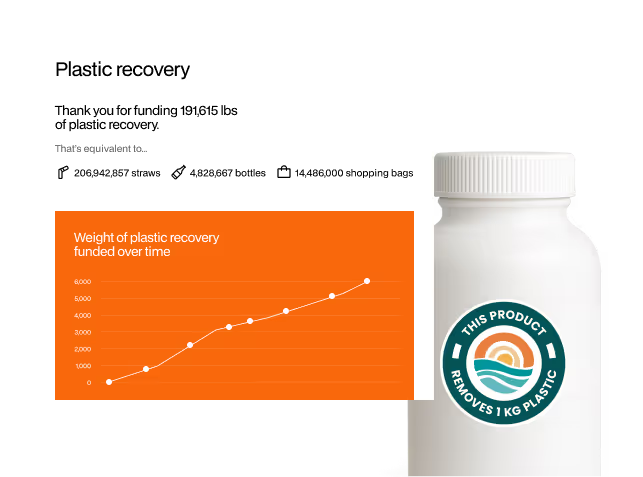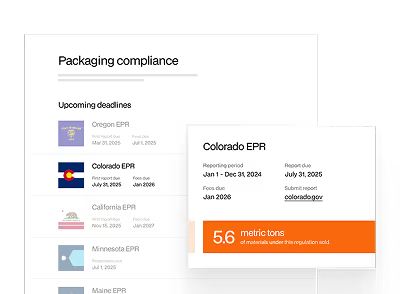Packaging design is no longer just a creative or engineering function. With the rapid expansion of Extended Producer Responsibility (EPR) laws, product teams are now on the front line of regulatory compliance, cost exposure, and corporate sustainability strategy.
Ignoring EPR in design can lead to rushed redesigns, cost spikes, or even lost market access. Embedding it early in the design process is not only cheaper, it can become a source of innovation and competitive advantage.
Why Packaging Teams Need to Care About EPR
- EPR is becoming global. Over 400 EPR policies exist across 60+ countries (OECD, 2024). The EU requires all packaging to be recyclable or reusable by 2030, while the U.S. already has seven states with EPR packaging laws.
- Costs are shifting. Under EPR, producers — not taxpayers — bear the costs of waste collection and recycling. In Canada, some provinces now require producers to cover 100% of system costs.
- Design has direct financial impact. Non-recyclable materials attract higher fees, while recyclable and PCR-rich designs reduce liabilities.
For product teams, this means packaging specs are no longer just technical decisions — they are financial and compliance levers.
For more context, see How to Streamline Complex EPR Compliance: 5 Essential Tips for Brands.
What EPR Looks Like in Packaging Design
At its core, EPR shifts the responsibility for end-of-life management of packaging from consumers and governments back to producers.
In practice, this means product teams must:
- Select materials with proven recyclability or reusability.
- Ensure accurate labeling for disposal.
- Track and report packaging composition, weight, and volume.
- Design packaging to align with recovery infrastructure in target markets.
Failure to do so can trigger penalties, non-compliance risks, or redesign “fire drills.”
Read more: How to Prepare for EPR 2025.
First Moves Product Teams Can Make Today
- Map packaging formats across your portfolio by material, weight, and recyclability.
- Flag high-risk items — multilayer films, black plastics, hard-to-recycle laminates.
- Engage suppliers on recyclable or compostable alternatives.
- Document SKUs and material data for reporting and compliance readiness.
- Pilot redesigns in high-volume or high-risk formats (bags, clamshells, pouches).
How to Bake EPR Into Your Design Process
EPR compliance should not be a one-off project. It should become part of design culture:
- Add EPR checkpoints into design briefs.
- Use supplier scorecards to verify recyclability and PCR content.
- Run lifecycle assessments during design to anticipate end-of-life impacts.
- Standardize formats where possible to improve recycling efficiency.
This is where rePurpose Global’s Packaging Compliance Platform comes in. The expert platform translates SKU-level packaging data into compliance requirements, forecasts EPR fees across markets, and recommends design changes that reduce regulatory exposure.
Product teams don’t need to become regulatory experts — they can leverage the rePurpose sustainability and compliance platform to integrate compliance into everyday design workflows.
Where the Rules Are Coming From (and Who’s Ahead)
- European Union: The European Union's Packaging and Packaging Waste Regulation (PPWR) mandates that all packaging must be recyclable or reusable by 2030, and sets various targets for minimum recycled content in plastic packaging, with further targets for 2035 and 2040. The regulation also introduces bans on certain single-use plastics, requires refill and reuse options for consumers, requires that digital labelling be incorporated into packaging, and sets overall waste reduction targets for packaging per capita.
- United States: A patchwork of state-level laws, led by California, Oregon, and Maine. By 2027, an estimated 40% of U.S. packaging volume could be covered by EPR. For context, see 2025 Update on U.S. Packaging EPR and Packaging Legislation. Many of thes states have developed ecomodulation plans and frameworks that identify bonuses and maluses for encouraging and discouraging certain packaging choices. Oregon, for example is focused on life-cycle impact of packaging, California is focused on source reduction for plastic packaging and making all packaging recyclable or compostable by 2032. Colorado is incentivizing incorporation of post-consumer recycled content, recyclability, reuse and refill.
- Asia: Rapid adoption in India, South Korea, and Indonesia, with a strong emphasis on producer-funded collection and recycling.
For global companies, this means packaging must be multi-market compliant — a design suitable for the U.S. may fail in the EU, and vice versa. The rePurpose Compliance platform can help brands map their products across EU, UK, Canda and USA, making it easier for design teams to find and correct issues.
Turning EPR Requirements Into Opportunities
EPR fees are not static — they are increasingly shaped by eco-modulation, where the cost a producer pays is directly linked to the recyclability, reusability, or environmental profile of their packaging.
- Penalty fees are levied on non-recyclable or hard-to-process materials such as multilayer laminates or black plastics.
- Incentives or reduced fees apply to packaging that is recyclable, uses higher percentages of post-consumer recycled (PCR) content, or demonstrates reuse potential.
For product teams, this means design choices directly influence the bottom line. A switch from multilayer films to recyclable mono-material packaging doesn’t just reduce environmental impact — it can lower compliance fees year after year.
Beyond cost, better packaging design also answers growing stakeholder demand for accountability:
- Consumers increasingly expect brands to move beyond “lightweighting” toward genuinely recyclable or reusable formats.
- Investors are pushing for packaging metrics in ESG disclosures, alongside carbon and water.
- Retailers are tightening supplier scorecards, requiring packaging that aligns with their sustainability goals and regulatory obligations.
In this sense, EPR is not only a compliance burden — it is a market signal. Companies that embed eco-modulation principles into packaging design can simultaneously:
- Reduce regulatory costs.
- Secure stronger retail and investor partnerships.
- Demonstrate authentic progress to consumers.
The takeaway: product teams that treat EPR as a design lens, not just a reporting requirement, can transform compliance into innovation and brand resilience.
Case Study: Tillamook – Avoiding Costly Compliance Risks
Tillamook, a U.S.-based dairy cooperative, faced growing exposure to packaging regulations across multiple markets. Like many food brands, their packaging portfolio included complex plastics and multilayer materials that fall under EPR schemes and recycled content mandates.
Without accurate compliance reporting, brands risk:
- Misclassification of packaging that inflates EPR fees.
- Non-compliance fines and a potential future loss of market access.
- Reputational risks if packaging claims don’t align with verified data.
By working with rePurpose Global’s Packaging Compliance Platform, Tillamook was able to:
- Run its SKU-level packaging data through rePurpose’s compliance engine, which mapped packaging types to EPR requirements in different states and countries.
- Identify misclassified packaging items that would have significantly inflated compliance costs.
- Generate audit-ready reports for regulators and retailers.
- Integrate packaging compliance data with broader sustainability reporting to strengthen investor confidence.
The outcome: Tillamook avoided nearly $100,000 in unnecessary EPR-related liabilities while building a stronger compliance foundation for future packaging regulations. Full case study here.
This case shows that EPR is not just a policy issue — it is a business-critical design and data challenge. By embedding compliance tools directly into packaging workflows, product teams can avoid financial shocks and use compliance as a strategic advantage.
FAQs on EPR and Packaging Design
What exactly is EPR?
Extended Producer Responsibility (EPR) is a policy approach where producers are financially and operationally responsible for the end-of-life management of their products and packaging. This includes covering collection, recycling, and reporting costs. It’s designed to incentivize better packaging design and reduce the burden on taxpayers. Learn more in our EPR Foundations: What Is EPR? article.
What does this mean for product teams?
It means packaging is no longer just a design or marketing decision — it’s a compliance and financial decision. Non-recyclable packaging can drive up EPR fees, while recyclable or PCR-rich designs reduce costs. Product teams must integrate EPR checkpoints into briefs, use supplier scorecards, and align design decisions with local infrastructure. See EPR Foundations: What are Material Specific Targets?.
How does Amazon treat EPR compliance?
Amazon requires sellers in markets such as Germany and France to provide proof of EPR compliance. Brands that cannot demonstrate compliance risk delisting or blocked sales. For guidance, see How to Prepare for EPR 2025.
Which countries are enforcing EPR now?
- EU: Uniform packaging and packaging waste regulations (PPWR).
- U.S.: Seven state-level laws already in place (California, Oregon, Maine, Colorado, etc.). See 2025 Update on U.S. Packaging EPR and Packaging Legislation.
- Asia: Rapid adoption in India, South Korea, and Indonesia, with producer-funded collection at the center.
- Canada: Some provinces already require producers to cover 100% of collection and recycling costs.
How does this affect packaging costs?
EPR schemes are increasingly eco-modulated: fees are higher for non-recyclable, multi-material, or carbon-intensive packaging, and lower for recyclable formats and PCR use. For instance, mono-material PET trays may attract lower fees than laminated pouches. See EPR Foundations: What Is Eco-Modulation?.
What happens if we don’t comply?
Consequences range from fines and surcharges to outright sales bans. In Germany, producers that don’t register their packaging with the Central Packaging Register cannot legally sell. Non-compliance also creates reputational risk in markets where consumers and retailers demand accountability. See The Risks of Ignoring EPR Deadlines.
How can rePurpose Global’s platform help?
The Packaging Compliance Platform helps:
- Translate SKU-level packaging data into specific EPR obligations by region.
- Forecast future compliance costs under multiple scenarios.
- Recommend design interventions to lower fees and improve recyclability.
- Generate audit-ready reports aligned with EU, U.S., and Canadian regulations.
This makes compliance manageable even for SMEs and ensures packaging design aligns with both regulatory and stakeholder expectations.
Start Early, Stress Less
For product teams, EPR is not an abstract policy issue. It is a design constraint, a financial driver, and a source of innovation.
By embedding EPR principles into packaging design — and using tools like rePurpose’s Packaging Compliance Platform — companies can reduce costs, avoid regulatory risks, and design packaging that works across markets.
The earlier teams act, the fewer costly surprises they face — and the stronger their brands will be in a marketplace where regulation, investors, and consumers all demand credible action on packaging.

.png)

.avif)
.jpg)
.jpg)






